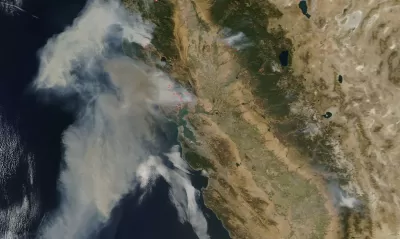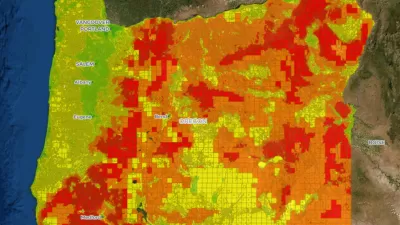As the state's worst wildfire season ever refuses to end, an analyst from UCLA considers how land use and building codes determine the location and extent of the damage.

As one of the worst wildfires in California history continues to extend the state’s worst wildfire season, Faith Kerns at The Conversation notes that which houses burn and which don’t is more predictable that it may seem.
While “[i]t is commonly thought that it takes direct flame to spread a fire,” she writes, it’s often embers that are to blame.
“These small bits of burning debris can be lofted long distances by the wind. They can then end up igniting landscaping materials like combustible mulch, or enter homes through vulnerable spots – gutters teeming with debris, unscreened attic vents, open or broken windows, old roofs with missing shingles.”
The damage to homes is also deeply affected by whether or not those areas are thought to be at risk, and whether or not building codes reflect that. Measures to decrease the damage to homes caused by wildfires can include regulations on building materials and building codes.
"Researchers recommend what is known as a “coupled approach” to home and building survival. This means the development and maintenance of an effective defensible space, as well as the careful selection of construction materials and correct installation to ensure that, for example, there are not gaps in siding or roofing that would allow embers to penetrate."
But in a state where there’s usually a building boom somewhere, the most effective method of prevention is also the most painful.
“Decision-makers also need,” Kerns writes, “to be willing to take on the most taboo topic of them all: recognizing that there are places houses simply shouldn’t be built, or rebuilt, at all.”
Seasonal wildfires have always part of the ecology of much of California, but they are becoming more frequent and more intense, in part due urban sprawl (the Wildland-Urban Interface) and in part due to climate change.
“It’s not something that we should, or ever could, hope to fully contain,” Kerns writes. “Our only chance is learning, really and truly and finally learning, to live with it.
FULL STORY: California fire damage to homes is less ‘random’ than it seem

Study: Maui’s Plan to Convert Vacation Rentals to Long-Term Housing Could Cause Nearly $1 Billion Economic Loss
The plan would reduce visitor accommodation by 25,% resulting in 1,900 jobs lost.

North Texas Transit Leaders Tout Benefits of TOD for Growing Region
At a summit focused on transit-oriented development, policymakers discussed how North Texas’ expanded light rail system can serve as a tool for economic growth.

Using Old Oil and Gas Wells for Green Energy Storage
Penn State researchers have found that repurposing abandoned oil and gas wells for geothermal-assisted compressed-air energy storage can boost efficiency, reduce environmental risks, and support clean energy and job transitions.

Private Donations Propel Early Restoration of Palisades Playground
Los Angeles has secured over $1.3 million in private funding to restore the Pacific Palisades playground months ahead of schedule, creating a modern, accessible space that supports community healing after recent wildfires.

From Blight to Benefit: Early Results From California’s Equitable Cleanup Program
The Equitable Community Revitalization Grant (ECRG) program is reshaping brownfield redevelopment by prioritizing projects in low-income and environmental justice communities, emphasizing equity, transparency, and community benefits.

Planting Relief: Tackling Las Vegas Heat One Tree at a Time
Nevada Plants, a Las Vegas-based nonprofit, is combating the city’s extreme urban heat by giving away trees to residents in underserved neighborhoods, promoting shade, sustainability, and community health.
Urban Design for Planners 1: Software Tools
This six-course series explores essential urban design concepts using open source software and equips planners with the tools they need to participate fully in the urban design process.
Planning for Universal Design
Learn the tools for implementing Universal Design in planning regulations.
Ascent Environmental
Borough of Carlisle
Institute for Housing and Urban Development Studies (IHS)
City of Grandview
Harvard GSD Executive Education
Toledo-Lucas County Plan Commissions
Salt Lake City
NYU Wagner Graduate School of Public Service





























